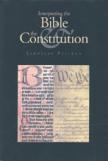We the (Faithful) People
This illuminating and engaging book examines similarities and differences in the techniques employed to interpret the Christian Bible and the Constitution of the United States of America. While this is not the only study of its kind, I know of no other that is so thorough and by such a distinguished author. Taking the form more of a probe than a definitive statement, this book seeks to open conversations rather than to close them.
Jaroslav Pelikan, Sterling Professor of History emeritus at Yale University, has long been recognized as the premier historian of Christian dogma in particular and of church history in general. The author of more than 40 books on diverse topics, including Jesus Through the Centuries (1986) and Credo (2003), he has taken a special interest in official confessions and pronouncements emanating from church councils and synods, and what it took to produce them. He takes their ideas seriously and avoids reducing them to matters of politics or sociology. He is especially interested in how these church statements interpreted and actualized the Scriptures.
Besides his teaching, writing and administrative activities, Pelikan has been part of the American academic and intellectual scene at its highest levels. When challenged by “secular humanists” and those outside the religious traditions to explain the relation of dogma to the Bible, he has found the most helpful analog to be the authority the U.S. Constitution has in American society and the role of the Supreme Court as its official and decisive interpreter. So in Interpreting the Bible and the Constitution, he considers the “official hermeneutics” that church councils and confessions have applied to the Christian Scriptures and that the Supreme Court has applied to the U.S. Constitution. Perhaps Pelikan’s greatest achievement is to show that “dogma” is not a bad or outdated word, and that the development of doctrine is not confined to theologians.
Pelikan first explains how the Christian Bible and the U.S. Constitution have come to function as “normative Scripture” for their respective constituencies. Each of these texts has been adopted by its community as its “norm” in the expectation that it will continue to be applicable to all kinds of crises and needs. Each text has generated various interpretive communities: “the faithful” and “we the people,” academic scholars in theology and law, pastors and lawyers, and the magisterium and the Supreme Court.
In interpreting or construing their normative texts, both interpretive communities are called upon to explain obscure statements and apparent contradictions, to produce learned commentaries and to apply their texts to new situations and crises. In matters of greatest difficulty, they fall back on a final arbiter: the Holy Spirit (often in the forms of church councils or the extraordinary magisterium), and the Supreme Court.
A key hermeneutical problem for both interpretive communities involves the place of the “literal sense” of Scripture and the “original intent” of the framers of the Constitution. In biblical studies this matter is often described in terms of the tension between historical criticism and the “fuller” or “spiritual” sense. In law it sometimes takes the form of a struggle between “originalists” and “progressives” or “judicial activists.” Pelikan demonstrates with interesting examples how these tensions have arisen throughout the history of Christian theology and of constitutional law. He also illustrates how a definitive choice between the two approaches is neither simple nor necessary, and that even the strongest defenders of the literal sense or original intent have not always been consistent.
This leads Pelikan to take up what is perhaps the greatest challenge facing both interpretive communities: the development of doctrine. The question is, how can the heritage of Scripture (or the Constitution) be faithfully preserved as the community applies and adapts it to changing circumstances? Here Pelikan follows the lead of one of his theological heroes, John Henry Newman, in his famous Essay on the Development of Christian Doctrine. To explain developments in Christian doctrine and in American constitutional law, he applies Newman’s seven criteria: preservation of type or ideas, continuity of principles, power of assimilation, logical sequence, early anticipation, preservative addition and chronic vigor.
To those acquainted with the canon of Pelikan’s writings on the history of Christian thought, it may come as a surprise that he is also knowledgeable about U.S. constitutional law. To most of us these seem like two different worlds. The author dedicates his book to the memory of his friend Edward H. Levi (1911-2000), who was dean of the law school and president of the University of Chicago, as well as attorney general of the United States in 1975-76. On the back cover is a glowing endorsement from Judge John T. Noonan, one of the most distinguished historians of law in our day.
To describe Pelikan’s essay as a tour de force is an understatement. While dealing with complex issues, the author expresses himself with a clarity that shows his great learning, and he buttresses his case with well-chosen examples and quotations. The book will have special appeal to biblical scholars, theologians and lawyers, because it shows how much they have in common as they try to understand, explain and apply their normative texts. But it is accessible to a wider audience of readers as well.
For those who wish to go more deeply into the rationale and methodology of Catholic biblical study there are no better resources than the Second Vatican Council’s “Constitution on Divine Revelation” and the Pontifical Biblical Commission’s document The Interpretation of the Bible in the Church (1993). Having read Pelikan’s newest work, I can easily imagine a wonderful parallel book that might be written comparing traditional Jewish law and U.S. constitutional law.
This article also appeared in print, under the headline “We the (Faithful) People,” in the December 20, 2004, issue.








